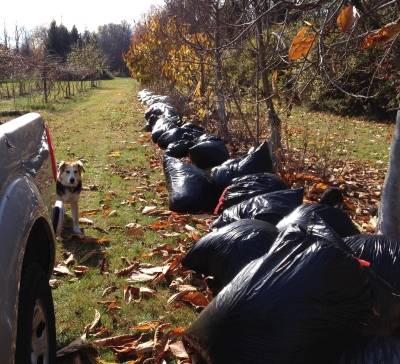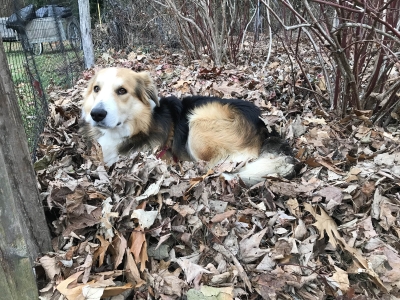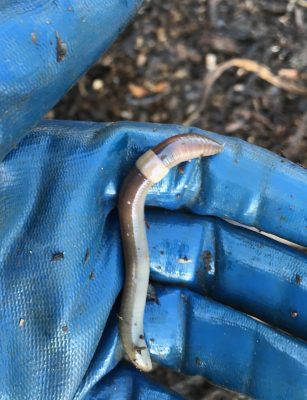Of Worms and Leaves, Here and Beyond
Unreiking is Good Exercise
For the past few days I’ve been engaged in the esoteric exercise of unreiking. Basically, this involves lifting heavy (or sometimes light) sacks, slitting them with a knife, and then moving my arms back and forth over the spilled contents. Okay, okay, the “sacks” are plastic bags, their contents are autumn leaves, and I’m holding a pitchfork in my hands as I spread out the spilled leaves.

Sammy is looking forward to this leafy mattress
(Unreiking is the reverse of another esoteric exercise, reiking, whereby . . . well, leaves are raked up into plastic bags.)
Some people have too many leaves or otherwise don’t want them around. I have too few leaves and have use for them. By unreiking, the leaves get spread beneath my berry bushes, grape vines, and pear trees. These leaves feed bacteria, fungi, and other soil microbes, which slowly rot down the leaves to enrich the ground with nutrients and add organic matter that helps the soil hold both moisture and air.

Ahhhhhh
After doing this autumn after autumn for many years, the ground beneath these plants is as good as any agriculture soil in the world.
A Gardener’s, Farmdener’s, and Farmer’s Friend, Reconsidered
Our forest soils are similarly enriched, though to a lesser degree, with each autumn’s leaf drop. But change is under way, and the culprit is the earthworm.
Backtrack to about 12,000 years ago; that’s when the last glacier receded from the northern parts of the U.S. The glacier froze, compacted, churned and moved soil everywhere north of New Jersey, the upper parts of Pennsylvania, Ohio, Indiana, and Illinois, and parts of Wisconsin and South Dakota. Most of North Dakota was also enveloped by the the glacier, as well as, moving further west, the northern parts of the northern most states. In so doing, it killed off any native earthworms.
The still existing native earthworms to the south could have migrated back up here, but they move very slowly. Earthworms’ top speed is estimated at less than 6 yards per year.
Here, north of that line of glaciation, you and I do see earthworms in our soil. They’re not native; they arrived here nestled within pots of soil and organic debris, and as discarded soil ballast in ships, beginning in about the 17th century, with European colonists. And they liked it here.
More recently, those European immigrants — the worms, that is — were joined by worms from Asia.
Both species of non-native earthworms continue to spread in the soil of potted plants, in compost and leaf mulches, in home composting kits, and in discarded fishing bait (“nightcrawlers”).
Problem is that a few species of these non-native earthworms are very good a decomposing the leafy mulch that blankets forest floors. The blueberry, mountain laurel, rhododendron and other shrubs and ground covers in our forests thrive in that leafy mulch. The action of these non-native earthworms threatens to change the character of our forests.
Eek, A Snake Worm!
A number of years ago, my friend Sandy told me of strange happenings in her garden, of the abundance of worms and worm castings to the extent that the soil became so loose that her plants were flopping over. I pooh-poohed this report until a bit of research revealed this invasive worm issue.
I couldn’t offer Sandy any advice on what to do and, in fact, there’s no recommended way to deal with invasive worms. Discarding fishing bait at the end of a fishing day is one way these worms spread. (Sandy’s husband does fish.) They also can be spread in potted plants and in composts that were insufficiently heated and in mulches. (Uh oh; what about all my leaf hauling?)
For all the compost I make and spread, and all the leaves and other organic materials I haul here to the farmden, I come upon surprisingly few worms. One did catch my eye the other day, something about the way it moved and its robustness.

Crazy snake worm?
Could it be the European Lumbricus terrestris? Could it be the Asian “crazy snake worm”(probably Amynthas agrestis or A. tokioensis). Judging from the crazy way it moved and the pale collar (clitellum) circling its body completely, I’m guessing it’s one of the crazy snake worms.
Earthworms have always been a friend of gardener and farmer. Charles Darwin was a notable champion of them. After spending a lot of time on his belly in observation of these creatures, he wrote up his observations in a book, The Formation of Vegetable Mould through the Action of Worms. Darwin calculated that earthworms (probably Lumbricus terrestris) brought 18 tons of nutrient-rich castings to the surface per acre per year, in so doing tilling and aerating the soil while rendering nutrients more accessible for plant use. He wrote that “worms played a more important role in the history of the world than most persons would at first suppose.”
In our forests, European and Asian earthworms can eliminate leaf litter and change the soil composition to create conditions that favor non-native plants, decrease native plant biodiversity, and result in less understory vegetation. To the gardener and farmer, earthworms are a friend.


Hi Lee,
Thanks so much for this interesting posts. Do you have any recommendations for buying and maintaining earthworm colonies at home for Vermicomposting?
Much appreciated,
Em
I contacted Tim McCay, Professor of Biology and Environmental Studies at Colgate University, who provided a very thorough answer to your question: “Most vermicomposting systems (including mine!) use Eisenia fetida, which is a non-native species. However, this species is only rarely found in nature. This is especially true in northern forests, which are often the most sensitive to invasive-earthworm effects. So, I personally see not reason to avoid vermicomposting, though I recommend using E. fetida (rather than another, potentially more problematic, species) and separating the system from nearby forests that might provide habitat for E. fetida. Under no circumstances should someone use one of the jumping worm species in a vermicomposting system.”
Hello, very interesting article. I would love to use this on our grapevines but am wondering how you keep your leaves in place to where they won’t blow away? Thank you.
I don’t mind a few blowing away. After some rain or snow, they pretty much stay in place.
I’ve heard of these through our local extension master gardener program. I’d hate to see our beautiful forests decline. I hope we find a way to rebalance the worm population. I wonder about millipedes now … there seem to be so many in my woodland summer retreat. They are fascinating to watch.
I have seen a sharp increase in these “snake worms” in the last year (eastern PA). Their robust movement and speed catch the eye. Large numbers have been found in my compost piles. They thrash from side to side as I attempt to lift them out of the debris, whipping themselves against my gloved hand. Very different from other worms I have seen here for 28 years. Hmmmm.Fascinating post, thank you!
Received the seeds from you yesterday. Thank you for your kindness in sharing them. I will make sure they don’t dry out & keep them in the foil till I plant them. I so enjoy reading your newsletters.
Thanks once again. Mariana in Carmichael, CA.
Very interesting post. I never considered the global impact of worms in this way. Thank you for sharing.
Well that was just a tease. More information please. What about the effect on gardens of the red wiggler used in vermicomposting?
How do you treat your leaves? Chopped? Or composted whole? More information please.
I contacted Tim McCay, Professor of Biology and Environmental Studies at Colgate University, who provided a very thorough answer to your question: “Most vermicomposting systems (including mine!) use Eisenia fetida, which is a non-native species. However, this species is only rarely found in nature. This is especially true in northern forests, which are often the most sensitive to invasive-earthworm effects. So, I personally see not reason to avoid vermicomposting, though I recommend using E. fetida (rather than another, potentially more problematic, species) and separating the system from nearby forests that might provide habitat for E. fetida. Under no circumstances should someone use one of the jumping worm species in a vermicomposting system.”
I have read that leaves destined for the compost pile should be shredded so that they don’t create an impermeable mat that prevents water from reaching the middle of the pile. Is there any sort of similar concern with mulching with whole leaves? I suppose mature trees might have roots that can pull moisture from deeper or wider than the mulched area, but would less mature trees or trees/shrubs with shallow root systems be adversely affected?
I wouldn’t worry about it. But I might combine mat forming leaves with a looser material such as straw or wood shaving (both of which come with the horse manure I haul here). A pile of leaves more than 4 feet high that a local landscaper dumps here each autumn is mostly rotted by the following autumn. How much depends on seasons’ rain and snow fall.
Good looking pooch!
Thank you for your postings.
About the leaves. What if they carry fungus, wouldn’t it be detrimental in a vegetable garden?
Nor likely. Fungi are everywhere, and most of them are beneficial. Not much chance of a fungus on leaves also being pathogenic to vegetable plant.
I specifically meant Septoria and Downy Mildew. Which were prevalent in our area, Ulster Co., past summer, especially, after continuous rains. So, they can’t be brought by maple or other trees’ leaves used as a mulch laid in a preceding fall?
Correct. Maple and other trees’ leaves will not bring in tomato diseases.
Do you have any problem with voles, especially under the leaves you have put around your plants.
Voles probably aren’t much of a problem here because of 2 outdoor dogs, one outdoor cat, and areas surrounding plantings are low mown grass.
Why voles would be specifically under the leaves? Also, are you sure they are voles, not moles? However, in either case my question would remain.
Nice soft earth, hidden from predators. The same would be the case for other loose, organic mulches.
For the past few days I’ve been engaged in the esoteric exercise of unreiking. Basically, this involves lifting heavy (or sometimes light) sacks, slitting them with a knife, and then moving my arms back and forth over the spilled contents. Okay, okay, the “sacks” are plastic bags, their contents are autumn leaves, and I’m holding a pitchfork in my hands as I spread out the spilled leaves.
Thanks
Thanks. I always like to learn of new esoterical practices to add to my (autumn) regime.
I have Asian jumping worms. I’ve read that they love leaf and wood chip mulches. For years I’ve been mulching my vegetable beds with crushed leaves and my paths with straw but now I’m afraid of encouraging these worms by mulching. Mulch is so beneficial I hate to give it up. But I don’t want any more of these crazy worms. What do you recommend, to mulch or not to mulch – Debbie
They are difficult to deal with. But . . .
•Cocoons are sensitive to heat and can be destroyed with clear plastic solarization; in late spring or summer, cover moistened soil with a sheet of transparent polyethylene for two/three weeks or until the soil temperature exceeds 104°F for at least three days.
•If you have a small population of jumping worms, handpick and destroy them by bagging them and throwing them in the trash, or place them in a bag and leave out in the sun for at least 10 minutes; then throw the bag away.
•Research is currently being conducted on invasive worms at the University of Wisconsin and several practices do show some promise of control. Abrasive materials such as biochar (ground up charcoal) and diatomaceous earth (fossilized diatoms) may show some promise in killing adult jumping worms. Incorporate one of these products into the infested soil to a depth where the worms are located; worms that come in contact with the materials will be adversely affected.
• Remove and destroy jumping worms when you see them. Seal them in a bag and throw them in the trash – the worms will not survive long. Reducing the adult population will eventually reduce the number of egg-carrying cocoons in the landscape.
•Research has shown that the biological insecticide BotaniGard can significantly reduce the abundance of jumping worms. Do not use the product near any pollinator animals.